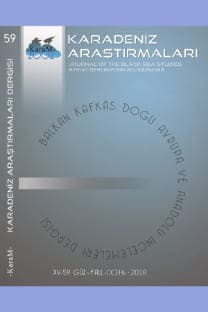Dil Edimi Açısından Halaççanın Konumu
Genel olarak, Halaççanın yok olma tehlikesiyle karşı karşıya olduğu çoktandır bilinmektedir. Ancak bu tehlikenin hangi seviyede olduğunu tespit etmek için değişik ölçütlerden hareketle incelemeler gerçekleştirilmelidir. Biz bu çalışmamızda Halacistan’ın 40 köyünden 58 katılımcıyla anketler gerçekleştirdik. Elde edilen bulgulara göre, dil edimi bakımından Halaçça 3,5 ölçeğiyle “savunmasız” ile “kesin tehlike” arasında konumlanmaktadır. Ancak diğer verileri göz önünde bulundurarak yapılan değerlendirmede, Halaççanın tehlike durumunun 1,7 ölçeğiyle, “ciddi tehlike” aşamasında olduğu görülmektedir.
Anahtar Kelimeler:
Halaçça, Türk dili, Dil ölümü, Tehlikedeki diller, İran Türk dilleri
Position of Khalaj Language in Terms of Performance
In general, it has been known for a long time that the Khalaj language is in danger of extinction. On the other hand, several studies have to be done in order to determine the level of the danger by using different criteria. In our study, some questionnaires were conducted with 58 participants from 40 villages. According to the results, the Khalaj language is between “vulnerable” and “definitely endangered” in terms of performance by the scale of 3.5. Nevertheless, in another evaluation done, taking into account the other data, the Khalaj language’s degree of endangerment is “severely endangered” by the scale of 1.7.
Keywords:
Khalaj language, Turkic languages, Dying Languages, Endangered Languages, Turkic languages of Iran,
___
- BAZIN, Louis (1998). « Les Turcophones d’Iran: aperçus ethno‐ linguistiques », Le fait ethnique en Iran et en Afghanistan. Paris: CNRS, s.43‐54.
- BOSNALI, Sonel (2010). “Halaççanın Yitim ve Değişim Sürecine Tasarlama Kipleri Açısından Bir Bakış”, bilig, 53 Bahar 2010, s. 67‐88.
- BOSNALI, Sonel (2009). “İran Halacistan Bölgesinin Etnik‐dilsel Yapısı ve Halaç Türkçesi”, Uluslararası Türklük Bilgisi Sempozyumu. Bildiriler‐1, Erzurum, s.191‐200.
- BOZKURT, Fuat (1992). Türklerin Dili, Cem yay., İstanbul.
- CRYSTAL, David (2007). Dillerin Katli, (Çev. Gökhan Cansız), Profil, İstanbul, 2007.
- DOERFER,Gerhard (1971). Khalaj Materials. Indiana University, Blooming‐ ton, Mouton& Co., The Hague, The Netherlands.
- DOERFER,Gerhard (1999). İran’da Türk Dil ve Lehçeleri ve Bunların Hayat‐ ta Kalma Şansı. Uluslararası Türk Dil Kurultayı 1996. Ankara: TDK Yay. s.303‐310.
- FISHMAN Jashua A. (1991). Reversing Language Shift: Theoretical and Empirical Foundations of Assistance to Threatened Languages. Cleve‐ don: Multilingual Matters.
- KIRAL, Filiz (2000a). “Reflections on –miş in Khalaj”, Evidentials (Turkic, Iranian and Neighboring Languages). Berlin‐Newyork: Mouton de Gruyter, 2000a, s.89‐101.
- KIRAL, Filiz (2000b). “Copied relative construction in Khalaj”, Studies on Turkish and Turkic Languages. Turcologica 46, Wiesbaden: Harrasso‐ witz Verlag, s. 181‐188.
- KRAUSS, Michael (1992). “The World’s Languages in Crisis”, Language 68, 1992, 4‐6.
- LEWIS, Paul (2005). “Towards a categorization of endangerment of the world’s languages”, SIL International.
- LEWISPaul,SIMONSF.G. (2009). “Assessing Endangerment: Expanding Fishman’s GIDS”, Revue Roumaine de Linguistique.
- ÖLMEZ, Mehmet (1995). “Türk Halkları ve Dilleri:2 ‐ Halaçlar ve Halaçça” , Çağdaş Türk Dili 84, 15‐22.
- WURM, Stephen A. (1998). “Methods of Language Maintenance and Revi‐ val, With Selected Cases of Language Endangerment in the World”, Studies in Endangerment Languages, Tokyo: Hituzi Syobo, s.191‐211.
- www.unesco.org/culture/ich/index.php?pg=00206 (15.03.2010).
- ISSN: 2536-5126
- Yayın Aralığı: Yılda 4 Sayı
- Başlangıç: 2004
- Yayıncı: Osman Karatay
Sayıdaki Diğer Makaleler
Kaysın kuliyev’in şiirlerinde vatan kavramı
Kamu Sektöründe Performans Yönetimi ve Uygulamada Karşılaşılan Sorunlar
Dil Edimi Açısından Halaççanın Konumu
Osmanlı Taşra İdaresinin Yeniden Yapılanma Süreci (1842-1876)
Bilinç altına dayalı etnik küfürler
Balkanlar: Etnik Karmaşanın Dilsel Boyutları
